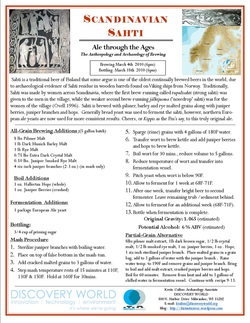
To brew this beer (minus the mushrooms), we need to look at the history of scandinavian brewing which includes an ale that was very popular in Scandinavia and Finland called Sahti. It traditionally contained malted barley, malted rye, juniper boughs and eventually, hops. Saunas were sometimes used to kiln dry or smoke the malted grains.
During the brewing cycle, juniper boughs are placed at the bottom of a hollowed out aspen log called a Kuurna, which is basically a lauter tun for extracting the flavors of the juniper and sugars from the malted grains. The bottom of the Kuurna is lined with rung-like straight pieces of wood to create a false bottom. One end of the Kuurna is fitted with a bunghole at the level of the bottom for draining the wort. Pretty amazing huh? These details were provided by a Discovery World Publication called The Age of Ales, which is a great resource for discovering ancient ales.
I am definitely brewing this recipe!
| scandinavian-sahti-recipe.jpg |
